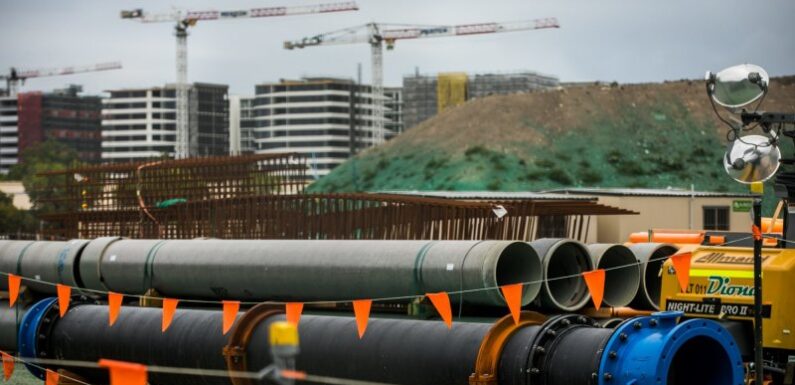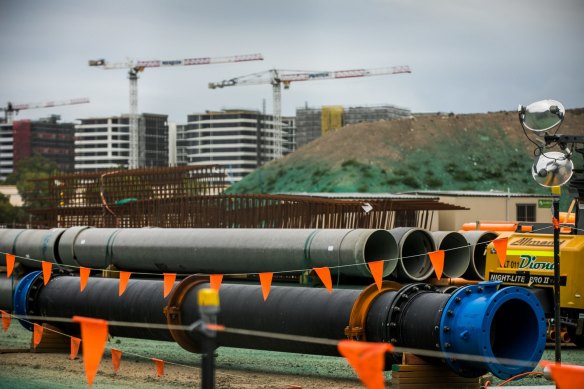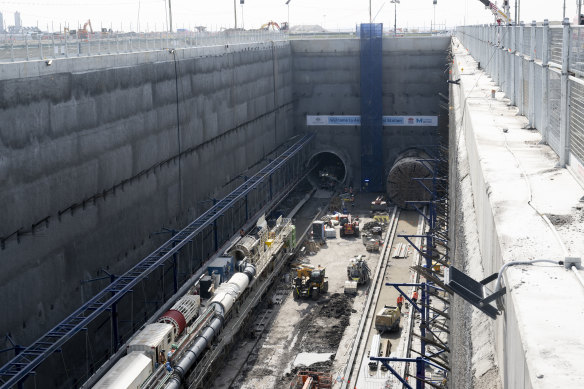
Save articles for later
Add articles to your saved list and come back to them any time.
Billions of dollars in infrastructure projects around the country are on the chopping block and more face years-long delays in an attempt to drive down inflation as borrowers brace for the Reserve Bank to lift interest rates again on Tuesday.
Ambitious state and federal road and rail projects were flagged by the International Monetary Fund last week as factors that could force the RBA to lift rates even higher. The IMF urged governments to slow down their big builds.
Major infrastructure projects around the country have gone under the microscope as estimated costs balloon and the government grapples with high inflation.Credit: Anna Kucera
On Sunday, Treasurer Jim Chalmers echoed warnings from Infrastructure Minister Catherine King that the government would make tough decisions on some of those projects when the infrastructure review is released in coming weeks.
“I do think we’re going to need to make some difficult decisions about the infrastructure pipeline, which factor in those $33 billion of blowouts from projects announced by our predecessors and which factor in our inflation challenge,” he said on the ABC’s Insiders program.
“I do think we need to be upfront about that, and the work that Catherine is doing engaging with the states is to work out how we get maximum value for money, how we get the right infrastructure for our people and for their economy, without putting additional upward pressure on inflation.”
State officials, speaking to this masthead on background so they could detail developments, said all are expecting major projects worth billions of dollars to be pushed beyond the budget forward estimates rather than axed outright. A delay would push the start date on many to the second half of this decade or even into the 2030s.
All governments have been reporting cost overruns for their projects, large and small, due to a mixture of staff shortages, supply chain delays and a lift in both wages and the costs of building products.
The states have more than $100 billion worth of road and rail projects under way, with projects worth hundreds of billions of dollars more either committed or under consideration.
NSW road and rail authorities are working on $36 billion worth of projects, while in Victoria the total is almost $85 billion. Victoria’s work includes the $35 billion Suburban Rail Loop project, while NSW is well advanced in the construction of the $5.3 billion Western Sydney airport.
Construction on the rail station at Western Sydney airport.Credit: Janie Barrett
In Queensland, another $24 billion worth of road and rail projects are being constructed by either state authorities or local councils. In Western Australia, the state is directly involved in $12 billion worth of infrastructure.
Many of the projects are well advanced, making it almost impossible to delay or cancel them.
But many others are only pledged or under consideration. This includes a proposed $4.5 billion series of works, including tunnels, through NSW’s Blue Mountains, which was paused earlier this year.
The federal government has its own infrastructure challenges, including a $16 billion blowout in the cost of the inland rail link between Queensland and Victoria, now expected to cost at least $31 billion.
The price tag for the Snowy Hydro 2.0 project started under the Turnbull government has blown out sixfold to at least $12 billion.
Infrastructure Minister Catherine King has been consulting state counterparts over the findings of the infrastructure review and will announce before mid-December which projects will be delayed or cancelled as part of the mid-year economic and fiscal outlook process.
NSW Treasurer Daniel Mookhey defended his government, saying it had already made sensible budget adjustments to infrastructure spending.
He said the federal government was allowing a large number of migrants into the country at the same time it wanted to boost the number of homes built across the country.
“The fact of the matter is that record immigration requires homes and infrastructure,” he said. “NSW expects any savings from the infrastructure review to come back to NSW to support this effort.”
Victorian Premier Jacinta Allan, speaking on Sunday at the West Gate Tunnel project, which has blown out by $3.3 billion, said the state was waiting for the federal government’s feedback on future building projects.
″We will have to wait for the federal government to conclude their review process and … give us their feedback in terms of the future different projects in that pipe,” Allan said.
“So the purpose of this review was to put on a stronger footing priorities … that we need to deliver for a growing country, but particularly here in Victoria, a growing city and state,” she said.
Economist and former Treasury official Steven Hamilton said that over the longer term new infrastructure increases supply, which reduces inflationary pressure, but in the short term, it increases demand which makes inflation worse.
“Deferring infrastructure investment is a very effective anti-inflationary tool; far more effective than relying on new infrastructure spending to boost the economy in a downturn. This is because it can be stopped much faster than it can be started,” he said.
The RBA is widely expected to lift interest rates from 4.1 per cent to 4.35 per cent on Melbourne Cup Day off the back of higher-than-expected quarterly inflation and strong spending figures.
Tuesday will mark Michele Bullock’s second board meeting as governor, but it will be her last without a deputy. Treasurer Jim Chalmers said a deputy governor would be announced before the December 5 RBA board meeting, after interviewing a small shortlist of candidates from Australia and overseas.
The treasurer will also introduce the Reserve Bank review legislation to parliament later this month. Chalmers said it was part of a suite of legislation that will be put to parliament in coming weeks, including legislating the objective of super and doubling the tax on superannuation earnings for balances over $3 million.
Cut through the noise of federal politics with news, views and expert analysis. Subscribers can sign up to our weekly Inside Politics newsletter.
Most Viewed in Politics
From our partners
Source: Read Full Article

